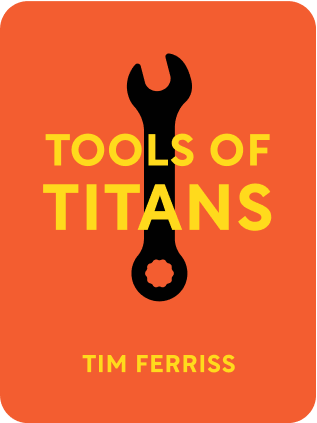

This article is an excerpt from the Shortform book guide to "Tools of Titans" by Timothy Ferriss. Shortform has the world's best summaries and analyses of books you should be reading.
Like this article? Sign up for a free trial here .
Do you have a question that you ask yourself every day? How can having a set of questions to ask yourself help spur your life in the desired direction?
If you want to build a better life, become more successful, and upgrade your lifestyle, you must constantly challenge your mind, thinking of ways to level up and spot opportunities. To this end, entrepreneur and lifestyle guru Tim Ferriss has a set of 17 questions he regularly asks himself.
Without further ado, here are Tim Ferriss’s questions to ask yourself.
Questions That Will Change Your Life
In his book Tools of Titans, Tim Ferriss stresses the importance of challenging your mind by asking yourself hard questions. He shares 17 of the questions he asks himself to further his goals. Try some of Tim Ferriss’s questions for yourself.
1. What if I do the opposite of what I normally do, for 48 hours?
If you’re stuck and not getting the performance you want, maybe you need to invert what you’re doing. If you try the opposite for just 48 hours, the damage is limited—at worst, you fail and go back to your normal routine. At best, you find a totally new successful way to do things.
As a salesman for a tech product early in his career, Tim wasn’t meeting his sales numbers. At a loss for what to do, he looked at what the other salespeople were doing, and decided to do the opposite. Other people worked 9 to 5; Tim decided to call outside of 9 to 5. He found that he was able to reach executives, who were still working outside normal business hours, and bypass their assistants, who were not.
2. For business ideas: what do I personally spend a lot of money on?
This is a perfect question if you want to start a business but you don’t know what problem to solve. Chances are, you’ve been solving that problem for yourself.
When the dotcom crash happened, Tim Ferriss wanted to start his own company. Instead of doing deep market research, he looked at his credit card statements – he was spending $500 per month on sports supplements on an annual income of $40k. This validated a personal need that he could turn into a business. Even better, as an avid consumer, he knew how the industry worked – which ads worked best, which vendors had the highest reputation. He created a supplement he couldn’t find on the market called BrainQUICKEN, launched a business, and paved the way to the 4-Hour Workweek and beyond.
3. If I had $10 million, what would I be doing differently? Do I really need $10 million to get this lifestyle today?
Are you enduring a crushing career, hoping to one day escape into the nirvana of retirement? Life is short—try to design the life you want today, rather than put it off 20-40 years into the future (when, heaven forbid, a tragic accident or illness might cut it short). Your ideal life might be deceptively easy to achieve.
While building BrainQUICKEN, Tim Ferriss was stretched to his energy limit and felt trapped in his caffeinated, overworked mental state. He stopped and asked himself what kind of lifestyle he really wanted.
After quick calculations, Tim realized his target lifestyle cost far less than he anticipated. The resource he lacked was time and flexibility, not cash. This motivated him to start redesigning his life immediately, before he even had $10 million.
4. What’s the worst that could happen? If it did happen, could I recover?
Anxiety has its roots in the uncertain. You don’t get anxious about turning on your faucet, because you know what’s going to happen. But you get anxious about asking someone on a date, or quitting your job to start a business, because you don’t know what’s going to happen.
This question pushes you to make your fear concrete. By defining your demons, they become easier to fight.
When Tim Ferriss was stressed about BrainQUICKEN, he dreamed of taking a year-long travel sabbatical. The business was running on all cylinders and he was intimately tied to its operations. So his dream remained a dream for 6 months.
Finally, he forced himself to question his assumptions. What was the worst that could possibly happen? Well, his business could grind to a halt and possibly go bankrupt. A quality issue could occur, and he’d get sued. His bank account would plummet, and his belongings would be stolen. Then he might contract malaria on his travels.
So…was that it?
After picturing the worst case scenario, Tim realized it really wasn’t that bad. Even in this worst case, he could recover. Even better, by defining the problems, he could tackle them today. If his business operations would fail in his absence, how could he make them more robust? How could he protect himself from malaria? These problems were easier than he realized.
5. If I capped my working time to 2 hours per week, what would I do?
How do you get the most out of your time? If someone pointed a gun at your head and forced you to work for only 2 hours a week, how could you maximize your chances of not getting fired? Use the 80/20 rule to find the best outputs of your time.
This question is especially good for managers. But even if you’re not a manager, it can also yield insights into your own work.
Tim Ferriss used this question to make his year-long sabbatical from BrainQUICKEN a reality. He focused on the concentrated products and customers that provided the most profits, and fired his highest-maintenance customers. He automated order handling to streamline operations.
6. Delegation: What if I give complete freedom for decisions up to $100? $500?
If you tend to micromanage, you’re limiting your output. You’re clearly proud of your work and you want to limit the number of mistakes, but you’re probably also overestimating the error rate of other people. This dramatically shortens your leverage, since you’re working on low-impact items other people should be taking care of.
When managing BrainQUICKEN, Ferriss spent 40 hours a week on customer service, fighting fires and answering questions. He’d get interrupted with special product requests or customs forms. He felt responsible for making the calls.
So (as per Question 1), he did the opposite—he gave power to his customer service agents. “If it involves less than $100, please make the decision yourself,” he emailed. To combat abuse, he reviewed these scenarios once a week with his staff.
Surprisingly, few catastrophes happened, and he gradually raised the threshold to $500 and then $1,000. Reviews went from weekly to monthly to never. Consequently, he reduced his personal customer service time spend from 40 hours/week to 2 hours/week.
7. What’s an underrated channel for marketing or promotion?
If you’re selling a product or service, this question more literally applies to you. How can you reach people in a way most competitors are ignoring?
When launching his first book, The 4-Hour Workweek, Tim Ferriss asked best-selling authors, “When promoting your book, what absolutely didn’t work? What would you do more of?”
Consistently, he heard about blogging. Without knowing much about blogging, he went to a trade show and hung around bloggers, eavesdropping on conversations and asking questions. This prompted him to start his 4-Hour Workweek blog, which led to his first viral posts.
(Shortform note: Even if you’re not selling a product, you may find ways to create value that go outside standard practice.
For example, if you’re an attorney, your competition is trying to make partner by billing a ton of hours. What if you looked the other direction, and you focused on getting new clients in?
If you’re trying to create a new Youtube channel (Youtube being an established, very crowded network), what new, up-and-coming channel could you establish yourself on first?)
8. Marketing: What if I don’t pitch my product directly?
People don’t like announcements or being sold products. They like hearing narratives.
When promoting his book The 4-Hour Workweek, Tim Ferriss couldn’t persuade journalists to introduce his book. But he fashioned engaging stories around concepts in the book. He showcased success stories from the book, people who redesigned their lifestyles. He wrote about his own personal body transformations, like in Geek to Freak. He released The 4-Hour Chef on audiobook for free on BitTorrent. These were stories worth spreading, and by extension his books got more publicity.
9. Education: Instead of a formal degree, what if I made my own degree?
Any graduate program or trained course costs a lot of cash and opportunity cost. Instead of attending the program, could you take all that money and get equivalent or better training?
Early in his career, Tim Ferriss thought an MBA might be useful for developing new skills, developing a better network, or having it look good on his resume.
Eventually he realized he could tie all three goals together in startup investing. Estimating the cost of an MBA at $120k over 2 years, he set aside $120k to make small $10k-20k investments in companies.
Importantly, Tim was prepared to lose it all—much as he would have lost the tuition to business school. This prompted him to actually take action rather than being scared. Even if his investments failed, he saw the experience and the added network as well worth the $120k. By learning from dozens of founders and investors, he created his own investment rules and made a few investments. His investments eventually panned out, making back double what he invested.
(Shortform note: Tim’s viewpoint can be applied to all graduate degrees, training programs, or even college. The actual monetary cost is often huge—MBAs can total $160k, including all expenses. Insidiously, the opportunity cost is huge, because when you’re in school, you’re not earning a salary.
For instance, if you want to get an MFA in Writing, this can cost $30k. You might also be giving up income of $50k. That $80k can go a huge way. You could sign up for master classes with the best writer in your area, paying $500/hr for custom feedback and mentorship. You could fund group dinners with aspiring writers as a way to network—even $500 per dinner can help you make 10 valuable connections.)
10. If I lost something, do I need to make it back the same way?
Have you lost something like an investment or opportunity? Your natural instinct is to make it back the same way you lost it. But this ignores the value of your time and could be inefficient.
In 2008, Tim Ferriss owned a house in San Jose and lost money in the recession. Selling then would mean a $150,000 loss. His friends counseled him to rent the house until the value could rebound. Tim followed the advice and was miserable from all the property management headaches that followed.
Instead, he realized the valuable asset here was his time, not cash. By babysitting his house, he might be able to recoup the $150,000 over 5 years. But using the same time and energy, he might be able to grow his brand and business by $500,000.
Tim decided to sell the house.
(Shortform note: When you’re stressed about a loss, you tend to obsess about it over and over, thinking about how to regain what you lost. But you have to poke your head above the weeds and find other routes.
Do you feel like you’ve lost ground in an argument? Maybe you don’t have to regain footing in that very argument. Cut your losses, admit your fault, and think about how to do better next time.
Have you lost the favor of your boss? Maybe you don’t regain it by repeating what got you there in the first place. Use your strengths and carve out another path to demonstrate your value. Hell, maybe even regaining stature in the current company isn’t the right approach, and it’s now time to join a new company.)
11. How could I solve this problem by simplifying and subtracting?
Removing things is often easier than adding things. What can you simplify to achieve growth?
This is counterintuitive, because it seems like more motion in more areas should lead to more progress. But your different activities have different ROI. And you should focus your energy on those.
Tim already showed subtraction when running BrainQUICKEN – how could he reduce his customer support time? How could he reduce the number of decisions he had to make? This prompted automation of order fulfillment and giving his employees more autonomy.
This applies to small tactical items too, like your product design or website. Removing the number of distracting items can improve conversion rate.
On a grander scheme, we’ve talked earlier about the importance of focus. By subtracting the number of things on your plate, you might simplify your life and achieve greater results.
12. How can I disappear for 4 to 8 weeks without having my business or work crash?
If you’re feeling burned out, some time away will help you regain clarity. Making sure your business or work runs smoothly while you’re gone will reveal optimizations you can implement today.
But this question is useful even if you don’t plan on taking any time off.
Tim Ferriss poses the question with two specific wordings:
- you specifically have to go “off the grid”—it’s not just a vacation. During this time, you cannot check your email.
- you also are away for 4 to 8 weeks. Taking off 2 weeks is too short—people will just let small issues pile up, knowing you’re back in 2 weeks. When they know you’re gone for 8 weeks, they have to solve the issues themselves.
Answering this question will reveal the ways in which you’re being a firefighter and not spending your time on the big picture. If you’re going away for 8 weeks, you have to entrust people with authority, clarify their goals, implement automated systems that streamline processes, and more.
This will allow operation of your business or work without your continuous presence, which in turn will reduce stress and help you focus on the big picture.
13. Am I hunting big game or small game?
Political strategist James Carville has an analogy of a lion hunting game. Hunting and killing a field mouse is relatively easy, but the energy required to do this exceeds the caloric energy of the mouse itself. Thus, a lion that hunted field mice would slowly starve and die.
Instead, lions need to hunt antelope. Antelope take more strength and energy to kill, but, once killed, they provide a lot more food for the lion.
The analogy for your life: focus on the big things that matter. Don’t chase all the small details, the field mice that are easy to kill but don’t move you closer to your goals. Many of us are addicted to the feeling of being busy. Having lots of obligations makes us feel needed by society. Importantly, it also signals to your friends that you’re so busy and important.
Instead, focus on the few big things that really matter. They’ll require more effort to accomplish, but they will make you thrive.
14. Might I actually be completely content?
You may be hard-wired to seek achievement, to be perpetually unhappy.
What if you can be happy with what you currently have?
Tim Ferriss found that expressing gratitude for his past and present has made him substantially happier. In his daily morning journal, he thanks 3 things that make him happy—like a good cup of tea or a friend he saw a year ago.
15. What would this look like if it were easy?
People tend to overcomplicate routes to success. Again, the feeling of struggle and being perpetually stressed makes what you’re working on seem so important.
What if it didn’t have to be this way? What if there was a way to apply your skills to a much bigger problem, where growth was easier to find?
Instead of improving things by 5%, where can you get a 5x improvement?
Don’t overcomplicate things or feel like you need to struggle. Like above, simplify for the greatest efficiency. Look for a way to roll a rock downhill.
If the answer isn’t simple, it’s probably not the right answer.
16. How can I use money to solve this problem? How can I use money to improve my quality of life?
The motivation here: the one limited resource affecting every person on Earth is time. If you can buy more time with money, this is often well worth it.
Tim Ferriss suggests that in your early career, you use your time to earn money. Once you’re further along, you should use your money to gain time.
If you have enough money to solve the problem, you don’t have the problem.
(Shortform note: Here are common examples that come to mind.
- Transit: taking public transit and walking might cost you $3 and take an hour. Taking an Uber might cost $6 and take 20 minutes.
- Cleaning: if you don’t enjoy cleaning and laundry, consider finding a housekeeper. In a city, you can buy $100 of cleaning that will save you 5 hours a month, and you end up with a cleaner house.
- Discounts: going out of your way to get small discounts may not be worth your time. If you’re spending 2 hours researching flights over a few weeks to save $40, it may fall under your hourly rate.
In doing all this, you might spend $200-300 per month to buy back dozens of hours of time. And these are just small everyday examples. If your hourly rate is high enough, you start opening avenues like hiring an accountant or a personal assistant.
You can then use this time to make yourself happier. This can be time spent on hobbies or pure relaxation. Or you can use the time in higher-leverage ways, like reading books to make you more personally effective.)
17. Can I take it easy and achieve nearly as much?
When you’re constantly stressed, you risk burnout and lower productivity. Having to take breaks then lowers your overall output. A train can travel faster than a car, but the train has to make stops at multiple stations while the car can keep coasting at a lower speed.
Derek Sivers gives the story of a 25-mile bike ride near his house. He’d push as hard as he could, sweating and huffing, and it’d take 43 minutes. This was stressful, so he decided to take it easy one day. He’ll go at less than his normal pace and enjoy the ride, admiring the blue sky and the birds. When he finished the ride, he found the ride took 45 minutes.
He endured extreme stress for just an extra 2 minutes.
The point being: You don’t need to go through life huffing and puffing. You’ll get nearly all the way there by putting one foot in front of the other, continuously..”
The US military has a saying: “Slow is smooth. Smooth is fast.”

———End of Preview———
Like what you just read? Read the rest of the world's best book summary and analysis of Timothy Ferriss's "Tools of Titans" at Shortform .
Here's what you'll find in our full Tools of Titans summary :
- The habits and beliefs of 101 people at the top of their game
- Tim Ferriss' list of 17 questions you should ask yourself to challenge your thinking
- How emulating the habits of successful people you look up to can make you successful as well






